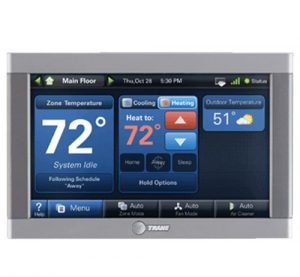As winter approaches, homeowners find themselves relying more on their heating systems to keep their families warm throughout the season. Even large corporations and offices have begun dusting off their furnaces to prepare for cold weather.
Every furnace has its own heating cycle that allows it to maintain your desired temperature throughout the day — but how often should your furnace cycle in winter? Many homeowners find themselves asking the same question at some point.
Generally, a furnace cycle lasts anywhere between three to 10 times every hour; however, the frequency changes depending on several factors.
If your furnace is cycling on and off more frequently than it should, there could be a problem with one of its internal components.
This article guides you through the various causes behind your furnace cycle issues and how you can fix each one.
How Often Should Furnace Cycle in Winter?
A furnace has a heat cycle wherein it turns on and off periodically to achieve a comfortable temperature in your home.
Measuring how often a furnace cycle should last in the winter isn’t an exact science. Furnace cycle frequency will depend on various factors, including:
- Outdoor conditions
- Thermostat configuration
- Indoor insulation
Furnaces may cycle anywhere between 3 to 5 times every hour if outdoor conditions are agreeable. As temperatures drop, you can expect this frequency to increase up to 8 or 10 cycles per hour.
What is Short Cycling?
Short cycling is when your furnace heating cycle significantly shortens, making your furnace turn on and off more frequently. This excessive stopping and starting places pressure on the furnace’s components, possibly shortening its life expectancy and affecting proper function.
Is my furnace short cycling?
Just because your furnace’s heating cycle is much shorter or longer than before, it doesn’t automatically mean that it’s short cycling. One way to know for sure is if your furnace turns on and off several times without producing heat.
A short cycling furnace works twice as hard to produce heat but fails to create any measurable warmth in your home. This causes strain on the furnace which may eventually lead to damage if left unchecked.
Things That Affect Furnace Cycles
As mentioned earlier, a few factors can affect the frequency of your furnace’s heating cycles. Here are some of the most common reasons:
Using the Wrong Size Furnace
Using the wrong size furnace in your home is the leading cause of abnormal furnace cycling.
Furnaces that are too small can’t warm your home as effectively or rapidly as a larger furnace. As a result, your furnace will need several cycles to produce enough heat to warm your house.
On the other hand, an oversized system may be able to heat your home much faster, but the distribution won’t be any better. In this case, the furnace will make fewer cycles to keep the temperatures equal in your home.
The best way to avoid either issue is to get a system that’s the right size for your home. If you’re unsure about what furnace size to get, contact an HVAC professional to get valuable insight and advice.
Dirty Furnace Filter
Another thing that could be causing your furnace to short cycle is a dirty or clogged filter. When your furnace filter is dirty, air can’t circulate properly inside the system, which can cause the heat exchanger to overheat.
Cleaning the furnace filter can get the air flowing properly again. It also saves you from having to get a new heat exchanger for your furnace.
Experienced DIY-ers can do the cleaning alone, but for more inexperienced homeowners, contacting an HVAC professional to perform the task is ideal.
What is a Heat Exchanger?
Every furnace system has a heat exchanger that’s in charge of heating the air in your home. It’s made of several metal coils that heat up when the burners are turned on. The coils will then transfer the heat to the air before releasing it into your home through the vents. That’s how you can enjoy hot air inside your home during winter.
Wrong Thermostat Setting
The thermostat tells your furnace when to turn on and off during furnace cycling. Essentially, it’s a way for you to control the indoor temperature in your house.
The number of times furnaces cycle will depend on the temperature that you’ve set your thermostat to. If you set it low during cold weather, your furnace will make less frequent cycling.
Meanwhile, if you set it the opposite way, it will also perform more frequent cycling.
What is the appropriate Thermostat setting?
Each person has their preferences and needs, so there’s really no single way to set your thermostat. However, if you want to achieve more efficiency, asking an HVAC professional to help you find the appropriate settings for you is key.
These technicians know how to set your thermostat, so it achieves optimal efficiency. They can also help you improve the indoor air quality of your home.
Malfunctioning Thermostat
If it’s not restricted airflow that’s making your furnace cycle more frequently, then it could be a malfunctioning thermostat.
The thermostat detects when your home has a high or low temperature and tells the furnace when to turn on and off to achieve complete indoor comfort.
If your thermostat malfunctions, your furnace will run continuously, not knowing when to stop or start again. Consequently, the furnace won’t be able to achieve or maintain a comfortable temperature in your home.
Avoid placing your thermostat under direct sunlight or where it’s too close to a heat source, such as the furnace air vents or the furnace itself. This can help prevent furnace short cycling and other thermostat dysfunctions.
Low Batteries
In many instances, low batteries in your thermostat could be what’s causing abnormal cycling in your heating system.
One way to make sure is to check the thermostat screen for flashing symbols or signs indicating that it’s low on batteries. If so, replacing the batteries can restore normal furnace cycles.
Contact a professional to help you replace the batteries in the thermostat if you’re unsure how to do it yourself.
Faulty Wiring
Another reason why your heating system is struggling to reach or maintain a comfortable temperature is faulty wiring. Your thermostat has wires connecting it to the furnace, telling it when to turn on and off.
Over time, these wires can deteriorate and fail, causing disruptions in the furnace’s functions.
An HVAC technician can help you find the issues in your wiring and offer effective solutions for the problem.
Damaged or Dirty Flame Sensor
The flame sensor is a part of the furnace that shuts the gas on and off when it detects a flame. It prevents harmful gas leaks in your home and is present in most gas and electric furnace systems.
A damaged or dirty flame sensor can’t detect burner flames as effectively, causing the furnace system to shut down. Consequently, it causes your system to short cycle in the winter.
One way to fix this is to clean the flame sensor, but keep in mind that furnaces have different designs and components. If you don’t know exactly where the flame sensor is inside your system, contacting a professional to assist you with the issue is best.
Outside Temperatures
When it’s winter, your gas or electric furnace will do everything to keep up with the outside temperature — even if it means it has to cycle more often. Regardless, a thin layer of snow on the ground shouldn’t be a reason for your furnace to cycle more often than it should.
When assessing if continuous cycles are caused by severely cold weather, several considerations must be taken, including your home’s insulation. Heat could be escaping through your windows, doorways, and roof. This can make it difficult for your furnace to regulate cycles.
So, How Often Should a Furnace Cycle in the Winter?
Short cycling is a common indicator that something is wrong with your heating system. Regardless, just because your furnace’s cycles have increased during the winter, it doesn’t mean it’s short cycling.
But how often should the system cycle in the winter?
The number of times your heat source runs a cycle every hour depends on several things, including outside conditions, home insulation, furnace size, and more.
However, if you suspect short cycling, it’s best that you contact a professional HVAC technician to help you resolve the issue.
Professional Furnace Repair, Maintenance, and Installation Services
BelRed Energy Solutions offers some of the finest furnace repair and heat pump repair services in the area. If you suspect something is wrong with your air conditioning, heating, or plumbing systems, we’re more than happy to help out.
Our technicians are trained in the latest technologies and methodologies to keep up with evolving industry standards. We strive to provide our clients with high-quality services, whether it’s to prevent harmful gas leaks or achieve better air purification in your home.
For professional furnace repair, maintenance, and installation, please don’t hesitate to reach out to us.
Call (855) 345-6161
We look forward to serving you!







